Chapter 5
Sending and Receiving E-Mail
In This Chapter
![]() Setting up e-mail accounts on your phone
Setting up e-mail accounts on your phone
![]() Reading e-mail on your phone
Reading e-mail on your phone
![]() Managing your e-mail folder
Managing your e-mail folder
![]() Sending e-mail from your phone
Sending e-mail from your phone
If you’ve had e-mail on your phone for a while, you know how convenient it is. If your Galaxy S6 phone is your first mobile phone with the capability to send and receive e-mail, prepare to be hooked.
I start this chapter by showing you how to set up your e-mail, regardless of whether your e-mail program is supported (more on that in a bit). Then I show you how to read and manage your e-mail. Finally, I tell you how to write and send e-mail.
Setting Up Your E-Mail
These days, many of us have multiple personal e-mail address for many reasons. Your phone’s E-mail app can manage up to ten e-mail accounts. With a Galaxy S6 phone, you may need to create a separate e-mail account through Google’s Gmail just for your phone. If you do not get a Gmail account, you’ll miss out on so many exciting capabilities. I highly recommend setting up a new Gmail account if you don’t have one already (more on that later).
The E-mail app on your phone routinely polls all the e-mail systems for which you identify an e-mail account and password. It then presents you with copies of your e-mail.
Setup is so easy, and having access to all of your e-mail makes you so productive, that I advise you to consider adding all your e-mail accounts to your phone.
Getting ready
In general, connecting to a personal e-mail account simply involves entering the name of your e-mail account(s) and its password(s) in your phone. Have these handy when you’re ready to set up your phone.
As mentioned, you can have up to ten e-mail accounts on your phone; however, you do need to pick one account as your favorite. You can send an e-mail using any of the accounts, but your phone wants to know the e-mail account that you want it to use as a default.
Next, you may want to have access to your work account. This is relatively common these days, but some companies see this as a security problem. You should consult with your IT department for some extra information. Technologically, it’s not hard to make this kind of thing happen as long as your business e-mail is reasonably modern.
Finally, if you don’t already have a Gmail account, I strongly encourage you to get one. Read the nearby sidebar, “The advantages of getting a Gmail account” to find out why.
Setting up your existing Gmail account
If you already have a Gmail account, setting it up on your phone is easy as can be. Follow these steps from the Apps menu:
-
Find the Gmail icon in the Apps list.
Here is a confusing part. The icon on the left in Figure 5-1 is the Gmail app. The icon on the right is for the general e-mail app. The general e-mail app is for your combined e-mail accounts. The general e-mail account is the app that you will use to access any and all of your e-mail accounts.
-
Tap the Gmail icon.
Because your phone does not know if you have a Gmail account yet, it offers you the option of entering your Gmail account or creating a new account. This page is shown in Figure 5-2.
-
Enter your Gmail account e-mail address.
Be sure to include the “@gmail.com” suffix. Tapping Next brings up the screen shown in Figure 5-3.
-
Enter your existing Gmail password.
Go ahead and type your password. When you’re ready, tap Next on the keyboard.
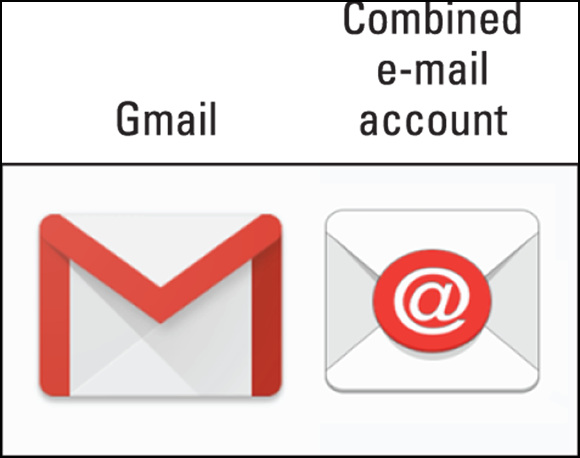
Figure 5-1: The E-mail and Gmail icons.

Figure 5-2: Add your account page.
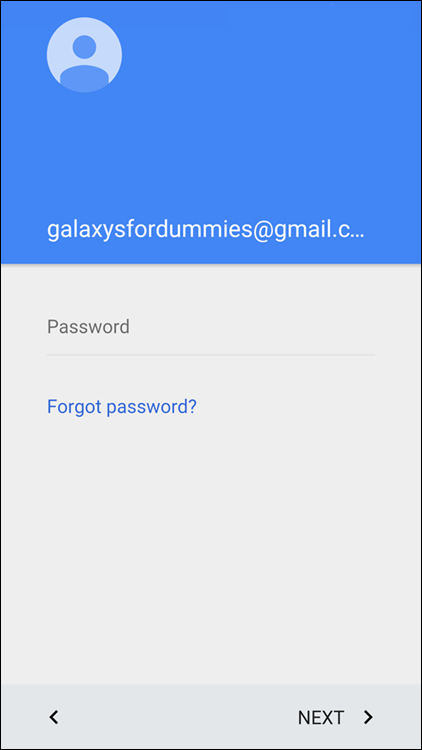
Figure 5-3: Enter your password on this screen.
You may get a pop-up re-confirming that you agree with the terms of use and all that legal stuff. Tap OK. You’ll see lots of flashing lights and whirling circles while your phone and your Gmail account get to know each other.
If everything is correct, your phone and your account get acquainted and become best friends. After a few minutes, they are ready to serve your needs. There are even a few screens that tell you all the things that your Gmail account will do for you.
If you have a problem, you probably mistyped something. Try retyping your information. From this point on, any e-mail you get in your Gmail account will also appear on your phone!
Setting up a new Gmail account
If you need to set up a new Gmail account, you have a few more steps to follow. Before you get into the steps, think up a good user ID and password.
When you have all of this ready, follow Steps 1 and 2 in the previous section, but tap the “Or Create a New Account” hyperlink when you get to the screen shown in Figure 5-2. From there, follow these steps:
-
Enter your first and last names on the screen and tap Next.
Google asks for your name in the screen that appears. This is how they personalize any communications they have with you.
 You may be tempted to use a fake name or some other clever two-word combination in place of a name. Don’t do it. You will still be getting e-mail to “Rita Book” or “Warren Peace” long after the humor has worn off.
You may be tempted to use a fake name or some other clever two-word combination in place of a name. Don’t do it. You will still be getting e-mail to “Rita Book” or “Warren Peace” long after the humor has worn off. -
Enter the username you want to use with Gmail and tap Done.
On the screen shown in Figure 5-4, enter the username you want. Hopefully you get this name approved on the first shot.
If your first choice isn’t available, try again. There is no easy way to check before you go through these steps. Eventually, you hit on an unused ID or you will use one of the suggestions in blue font. When you’re successful, it will congratulate you.
-
Accept the terms and conditions of the account.
You may want a lawyer to review these terms and conditions. Or not. Basically, the terms are that you should be nice and not try to cheat anyone. Don’t abuse the privilege of having the account.
-
Prepare a security question and an alternate e-mail address.
If you forget your password, Google wants to verify that you’re really you and not someone pretending to be you. Google does this check by sending a confirmation e-mail to another account or sending a text to your phone. You can do this now or tap Skip to do it later.
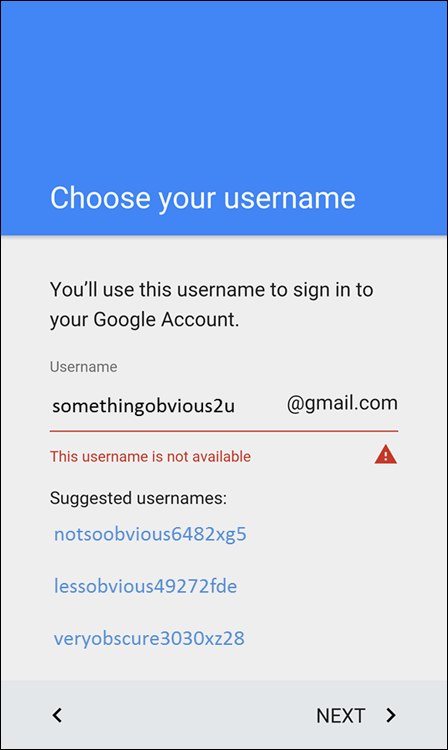
Figure 5-4: The Username screen.
After you tap Done, light flashes and you see the screen working away. This process usually takes less than two minutes. While you wait, you’ll see all kinds of messages that it’s getting ready to sync things. Don’t worry. I’ll explain these messages in good time. For now, you can add any other e-mail accounts you want by following the steps in the next section.
Working with non-Gmail e-mail accounts
Your phone is set up to work with up to ten e-mail accounts. If you have more than ten accounts, I’m thinking that you might have too much going on in your life. No phone, not even the Galaxy S6, can help you there!
We will now cover the steps to adding your e-mail accounts. Once you tell your phone all your e-mail accounts, the E-mail screen will let you see the inbox of each account or combine all your e-mail in a single inbox. You can choose which option works best for you.
To get started, have your e-mail addresses and passwords ready. When you have this, go to your phone’s Home screen. Look for the Mail icon; it is an envelope with an “@” on it (see Figure 5-1). This is probably on your Home screen as one of the five primary shortcuts just above the device Function keys or in your application list.
Adding your first e-mail account
-
Tap the Menu icon from the E-mail screen.
This brings up a menu like the one shown in Figure 5-5.
-
Tap the Others icon.
This is a generic way to enter lots of kinds of e-mail accounts. If you have an e-mail account on Yahoo!, AOL, Outlook.com, or another e-mail service that is on your screen, you can tap that icon. However, the process and the result will be the same. Tapping one of these icons brings up a screen that looks like the image shown in Figure 5-6.
-
Carefully enter your full e-mail account name, and then enter your password in the second field.
 Your e-mail address should include the full shebang, including the @ sign and everything that follows it. Make sure to enter your password correctly, being careful with capitalization if your e-mail server is case-sensitive (most are). If in doubt, select the option that lets you see your password.
Your e-mail address should include the full shebang, including the @ sign and everything that follows it. Make sure to enter your password correctly, being careful with capitalization if your e-mail server is case-sensitive (most are). If in doubt, select the option that lets you see your password. -
Tap Next.
You see all kinds of options you can select. Just go with the default settings for now. This will bring up the screen seen in Figure 5-7.
-
Select your desired Sync Settings.
You can select how often you want your phone and the e-mail service to synchronize. There has been a lot of thought and consideration put into the default settings. If you just want to get started, tap Next. If you want to fine-tune things later, it is not hard to go back and adjust these settings. These settings are intended to be gentle on your data usage. If you want images in e-mail to download immediately, store older e-mail messages on your phone, check to see if you have new e-mail all the time, you can change these settings on this page for this e-mail account. If you know what you want that is different from the default settings, make the changes and then tap Next.
-
Enter a name for the new e-mail account.
The next screen is seen in Figure 5-8. This gives you the option to call your e-mail account something other than its address. You can always use the e-mail address for the name, but I recommend choosing something shorter, like Joe’s MSN or My Hotmail.
-
Tap Done.
Using Figure 5-9 as an example, you can see that my account is now registered on my phone. It worked!

Figure 5-5: The menu for the E-mail app.

Figure 5-6: The Add Account screen.

Figure 5-7: The Sync Settings screen.
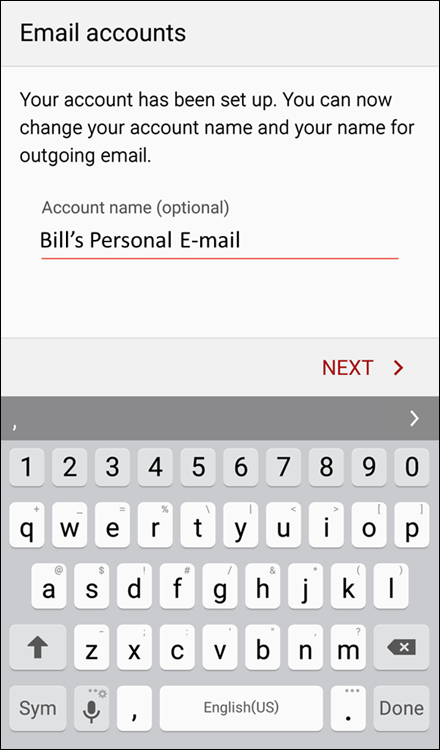
Figure 5-8: Naming your e-mail account.
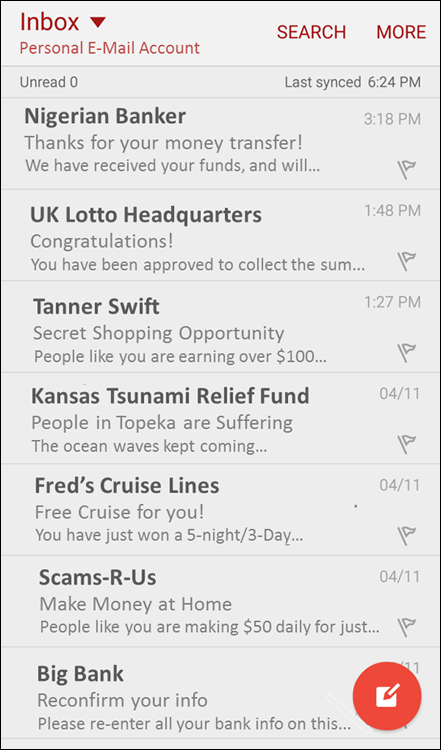
Figure 5-9: The E-mail Home screen.
Adding additional e-mail accounts
Once you have entered your first e-mail account, there are a few different steps to add additional accounts.
-
Tap the More hyperlink at the top right part of the screen.
This tap of the More hyperlink brings up the pop-up screen seen in Figure 5-10.
-
Tap Settings.
Tapping Settings brings up the screen seen in Figure 5-11.
-
Tap Add Account next to the green plus sign.
This brings you back to the Set-up e-mail screen seen back in Figure 5-5.

Figure 5-10: The More pop-up.
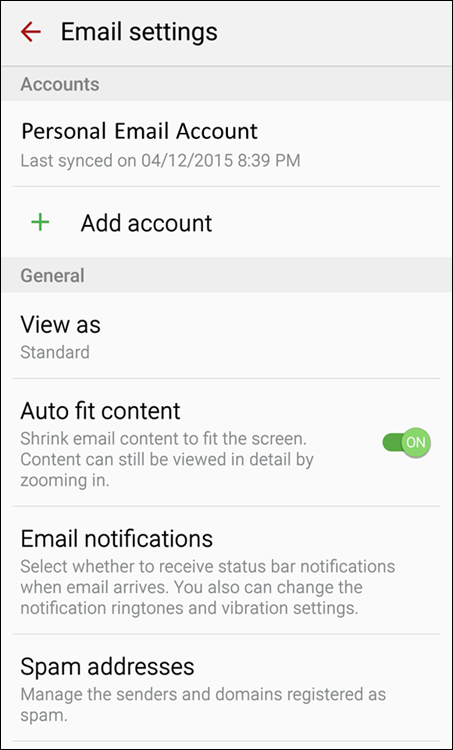
Figure 5-11: The E-mail Settings screen.
At this point you can add up to nine more accounts, and remember, you will be asked which e-mail account you want to be your primary account. It is entirely up to you. You can send and receive e-mail from all your accounts by selecting it, but only one can be the primary account used if you send an e-mail from another application, such as the Contacts app.
Setting up a corporate e-mail account
In addition to personal e-mail accounts, you can add your work e-mail account to your phone — if it’s based upon a Microsoft Exchange server, that is, and if it’s okay with your company’s IT department.
Before you get started, you need some information from the IT department of your company:
- The domain name of the office e-mail server
- Your work e-mail password
- The name of your exchange server
If the folks in IT are okay with you using your phone to access its e-mail service, your IT department will have no trouble supplying you with this information.
Assuming that your company wants you to be more productive with no extra cost to the company, the process for adding your work e-mail starts at your E-mail Home screen seen in Figure 5-5.
- From the E-mail Home screen, tap the Corporate icon.
-
Enter your e-mail address and password.
The Corporate screen is seen in Figure 5-12. It is similar to the screen shown in Figure 5-6, but this time, in Figure 5-12, I have closed the keypad and can see the full screen.
-
Tap Manual Setup.
This brings up the screen seen in Figure 5-13.
The chances are that you haven’t got the foggiest notion what any of this means or what you are to do now.
-
Verify that your IT department is good with you having e-mail on your own device and have them give you the necessary settings.
It is increasingly common that a firm will give you access on your phone. At the same time, they do not generally circulate documents with how to make this happen. This would be a big security problem if anyone could get access. Save yourself the time and get help from IT.
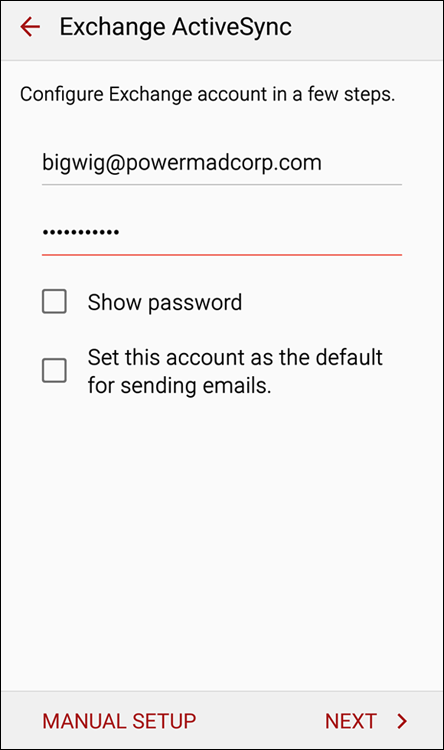
Figure 5-12: The Corporate set up e-mail screen.
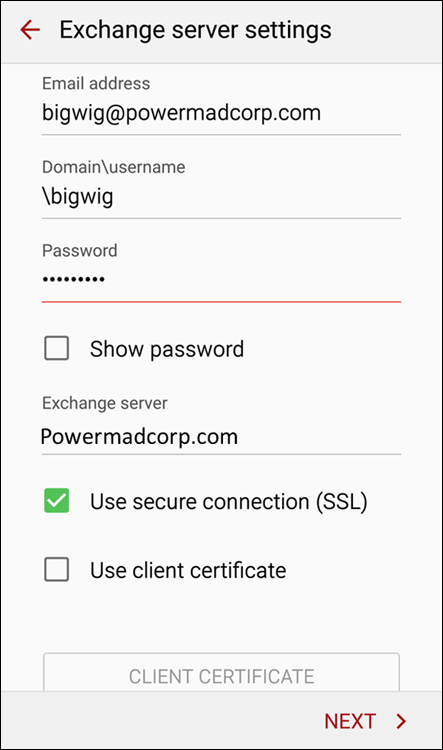
Figure 5-13: The Manual Setup screen for adding corporate e-mail accounts.
Reading E-Mail on Your Phone
In Figure 5-9, you can see how the e-mail screen looks for what I have called Personal E-mail Account. You can also set it up so that this screen combines all your e-mail into one inbox. At any given time, you might want to look at the accounts individually or all together.
To look at all your e-mail in one large inbox, tap the downward pointing arrow next to the word Inbox and select Combined Inbox. This lists all your e-mail in chronological order. To open any e-mail message, just tap it.
If, on the other hand, you want to see just e-mail from one account, tap the box at the top that says Combined Inbox. When you tap this icon, your phone will display all the individual e-mail accounts. Tap on the account you want to focus on at the moment, and your phone will bring up your e-mail in chronological order for just that e-mail address.
Writing and Sending E-mail
Here’s the logic that determines which e-mail account will send this e-mail:
- If you’re in the inbox of an e-mail account and you tap the Compose icon after tapping Menu, your phone sends the e-mail to the intended recipient(s) through that account.
- If you’re in the combined inbox or some other part of the e-mail app, your phone assumes that you want to send the e-mail from the default e-mail account that you selected when you registered your second (or additional) e-mail account.
When you tap the Compose icon in the Menu pop-up menu, it tells you which account it will use. The E-mail composition screen shown in Figure 5-14 says this e-mail will be coming from this account: [email protected].

Figure 5-14: The E-mail composition screen.
As shown in this screen, the top has a stalwart To field, where you type the recipient’s address. You can also call up your contacts, a group, or your most recent e-mail addresses. (Read all about contacts in Chapter 6.) Tap the address or contact you want, and it populates the To field.
Below that, in the Subject field, is where you enter the e-mail’s topic. And below that is the body of the message, with the default signature, Sent from my Samsung Galaxy S6, although your cellular carrier might have customized this signature.
At the top of the screen are three hyperlinks:
- Attach: Tap this hyperlink to attach a file of any variety to your e-mail.
- Send: Tap this link to send the e-mail to the intended recipient(s).
- More: Tap this option and you get the pop-up seen in Figure 5-15. This gives you the following options:
- Save in Drafts: This allows you to complete the e-mail later without losing your work.
- Send e-mail to myself: This is an alternative to saving the e-mail in your Sent mail folder.
- Priority: This option signifies that this is more important than the average e-mail to your recipients.
- Security options: You have some fancy, 007 options here. You can sign the document or encrypt it.
- Turn on Rich Text: To save data usage, e-mail is sent in a default font. If you want to burn a little more data, you can get creative and add more elaborate fonts.
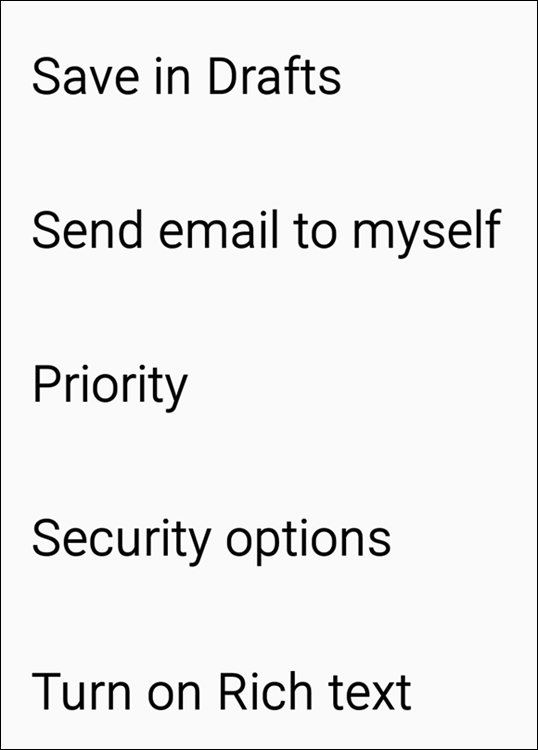
Figure 5-15: Composition e-mail options.
If you change your mind about sending an e-mail message, you can just tap the Back key. If you’re partially done with the message, you’re asked whether you want to save it in your Drafts folder.
The Drafts folder works like the Drafts folder in your computer’s e-mail program. When you want to continue working on a saved e-mail, you open the Drafts folder, tap on it, and continue working.
Replying To and Forwarding E-mail
Replying to or forwarding the e-mail that you get is a common activity. You can do this from your E-mail app. Figure 5-16 shows a typical open e-mail message.

Figure 5-16: An opened e-mail.
You can Reply by tapping the icon with the return arrow at the bottom of the screen. If other people were copied on the e-mail, you could tap the double return arrow to Reply All.
When you tap either of these options, the Reply screen comes back with the To line populated by the sender’s e-mail address (or addresses) and a blank space where you can leave your comments. (In the case of Figure 5-16, you could ask that your Dad not send you any more jokes like these.)
To forward the e-mail, tap the arrow pointing to the right above the word Forward, and enter the addressee just as you do when sending a new e-mail.
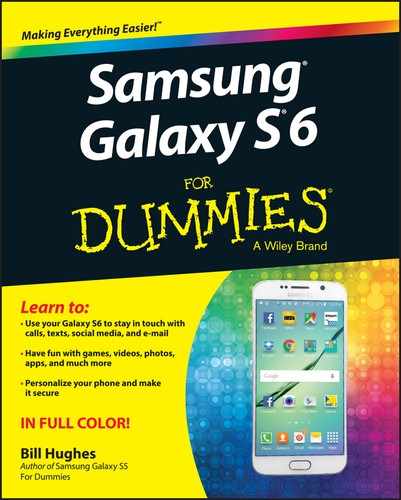
 Using e-mail on your phone requires a data connection. Some cellular carriers solve this problem by obliging you to have a data plan with your phone. If your cellular carrier does not, you won’t be able to use e-mail unless you’re connected to a Wi-Fi hotspot. I strongly recommend that you get that data plan and enjoy the benefits of wireless e-mail.
Using e-mail on your phone requires a data connection. Some cellular carriers solve this problem by obliging you to have a data plan with your phone. If your cellular carrier does not, you won’t be able to use e-mail unless you’re connected to a Wi-Fi hotspot. I strongly recommend that you get that data plan and enjoy the benefits of wireless e-mail.